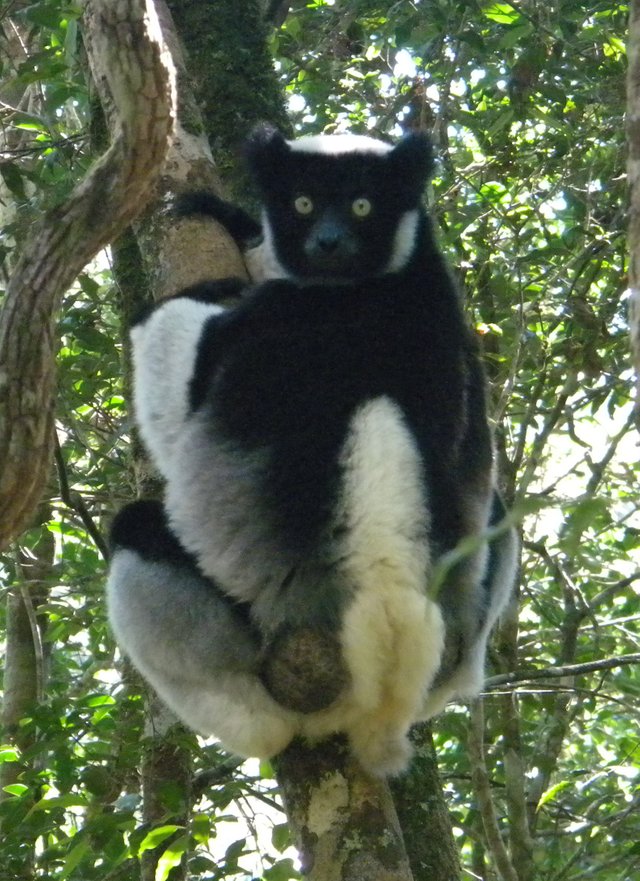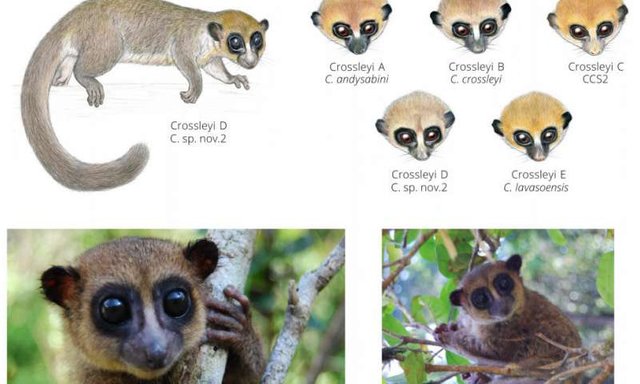A new species of lemur has been discovered on the Southeastern Madagascar, making it the 133rd lemur species
The lemurs are a clade of primates that are only found on the island Madagascar, just off the eastern coast of sub-Saharan Africa. They are genetically unique, and separated from the other primates at about 63 million years ago. After separating from the other primates, the lemurs have evolved independently on Madagascar, and have even had a convergent evolution that allowed them to have some very unique species of lemurs that fills otherwise vacant ecological niches. This has lead the lemurs to having some of the smallest primates in the world, and at one point they also had one of the largest primes ever known, which really shows how differently they evolved.

An indri (Indri indri), one of the largest lemurs (and not the one the title is about). Image by Erik Patel, posted with the Creative Commons Attribution-Share Alike 3.0 Unported license.
A new species of lemur has been discovered
As mentioned in the title of the post, a recently published paper in Primate Conservation has found and described a completely new-to-science lemur, called the Grove's dwarf lemur (Cheirogaleus grovesi). This new species is about the size of a American red squirrel (Tamiasciurus hudsonicus), so the dwarf part of the name is not without meaning. The Grove part of the name is a tribute to Colin Groves, a zoologist who have described over 50 new species in his career.
Grove's dwarf lemur was found in two different locations on Madagascar, but both were in national parks, meaning that it will most likely have a natural protection despite not having been classified as either threatened or non-threatened yet (these reports take a lot of time to do). One of the locations is a dense rainforest, while the other is actually pretty different; a mix of forest and grassland. This could suggest that it could have been a lot more widespread, since it does not seem to be tied exclusively to one niche (this last sentence is my own speculation, and not written in the paper).

Some images of Grove’s dwarf lemur, as well as illustrations that compare it to closely related species. Illustrations by Stephen D. Nash ©Conservation International. Photographs by Edward E. Louis, Jr.
The newly found lemur is also really cute, with large, black eyes, a long, fluffy tail, ears that look like that of a teddy bear, and dexterous hands. It spends most of its time in the canopy, where they live, eat and reproduce. The research team had to use dart guns to capture them, and took both blood and tissue samples that were used for DNS analyses to make sure it was in fact a new species.
There might be more lemur species coming soon!
The paper also mentions the fact that many new lemur species are likely to be described in the near future, since there have been a lot of new discoveries in the last few years. It does however take a long time to fully describe a new species, and this process means that there could potentially be lots of undescribed samples in labs around the world (or they might show that these are just phenotypically different members of another already described species).
Thanks for reading
Thank you for reading my post about the newly described Grove’s dwarf lemur. If you are interested in learning more, then I suggest that you check out the published article in Primate Conservation. It is available for free, so there’s no reason to not take a look at it. The Wikipedia entry on Evolution of lemurs is also really good if you want a closer look at how the evolved differently from the monkeys and apes.
Hey valth,
I have always had an interest in Lemurs because of how important they are in showing paths of evolution. Away from predators on mainland Africa, they’ve been able to evolve in a way completely different to their primate cousins.
It’s similar to here in Australia, with Tasmanian wildlife such as the Tasmanian Devil being able to evolve and thrive away from predators (Dingos) found on the mainland.
Thanks for sharing mate, your blog is really interesting to read and follow. Hopefully see you around!
Yeah, it is really cool to see how some animal groups evolve when they are "alone" on large islands. There are some cool examples of this all around the world, such as the ones you mention on Tasmania (and in Australia in general). I'm glad you like me blog! Thanks for following and leaving a good comment, @forexbrokr.
I think the canopies of our forests are one of the great unknowns.
I assume that this is mostly due to the difficulty of getting up into the canopy to study it.
I was reading about a study recently in the rainforest canopies of Panama:
It makes sense that most of the life is in the canopy because that's where the food is - leaves, fruit, seeds, birds .....
Very cute Lemur!
Yeah, I think you are spot-on with this statement. It's very interesting that we have such a big problem with getting to the canopies, because we always learn something new when a scientists actually manages to get samples from it. I remember reading about a research group that sprayed the canopies with gases to make the insects fall to the ground, and they found that something like half of them were completely new to science. We also find a new mammal or bird every once in a while in the canopies ;)
Thanks for the comment!
This shows us the very little knowledge that we have of our planet. ..
So much to learn and discover!
Even the abyss dark depths of seas are unexplored.
Biodiversity is indeed awesome on our little home.
Yeah, we still have so many species to discover, @xabi! Some scientists believe that we have found as few as 1 % of all the species on the earth, so there's many more to find. Of course most of these are very small insects and other tiny organisms, but there are still also mammals and big marine animals to be discovered.
SO AWESOME!
what a huge and cute lemur is An indri ! <3
it looks like a mix between a panda and a lemur :)) hopefully the father is the lemur
Joking :))
the one discovered is so petite and adorable!
cheers @valth
Thanks for the comment, @alexandraioana26 :) I agree, the indri is very cute!
I would like to go there just see these lemurs! They are so cute.I'm happy for discovering new species of lemur :) Thanks for the post and information. Have a nice day!
Have a nice day as well, @cemke! I would also very much like to visit Madagacar one day to see lemurs in the wild for myself. It seems like a really nice place.
Cute lemur, lOoking so stairing at me :D
@valth beside this, you'r visited other counteries ?
Hello, @sanach.
Sadly I have not visited Madagascar; the knowledge is from reading about the lemurs only, and the photographs are from Wikimedia Commons (but posted with permission of course). I have however seen lemurs in the zoo ;)
I haven't really visited many countries outside of Europe, so nothing too exciting to share on that front unfortunately.
Alright ! You live in Europe
Yes, I live in Norway.
The more I learn, the more I realize how much I don't know seems to be cute lemur. Big eyes and fluffy tail nice share @valth
Thank you :)
@originalworks
The @OriginalWorks bot has determined this post by @valth to be original material and upvoted it!
To call @OriginalWorks, simply reply to any post with @originalworks or !originalworks in your message!
Wow nice post.A new species of lemur has been discovered on the Southeastern Madagascar, making it the 133rd lemur species.
Its really informational post.
I'm glad you liked it, @moniristi.
Thats a A great info of animals its can be great info i appreciate your post @valth
Thanks, I'm glad you liked it :)